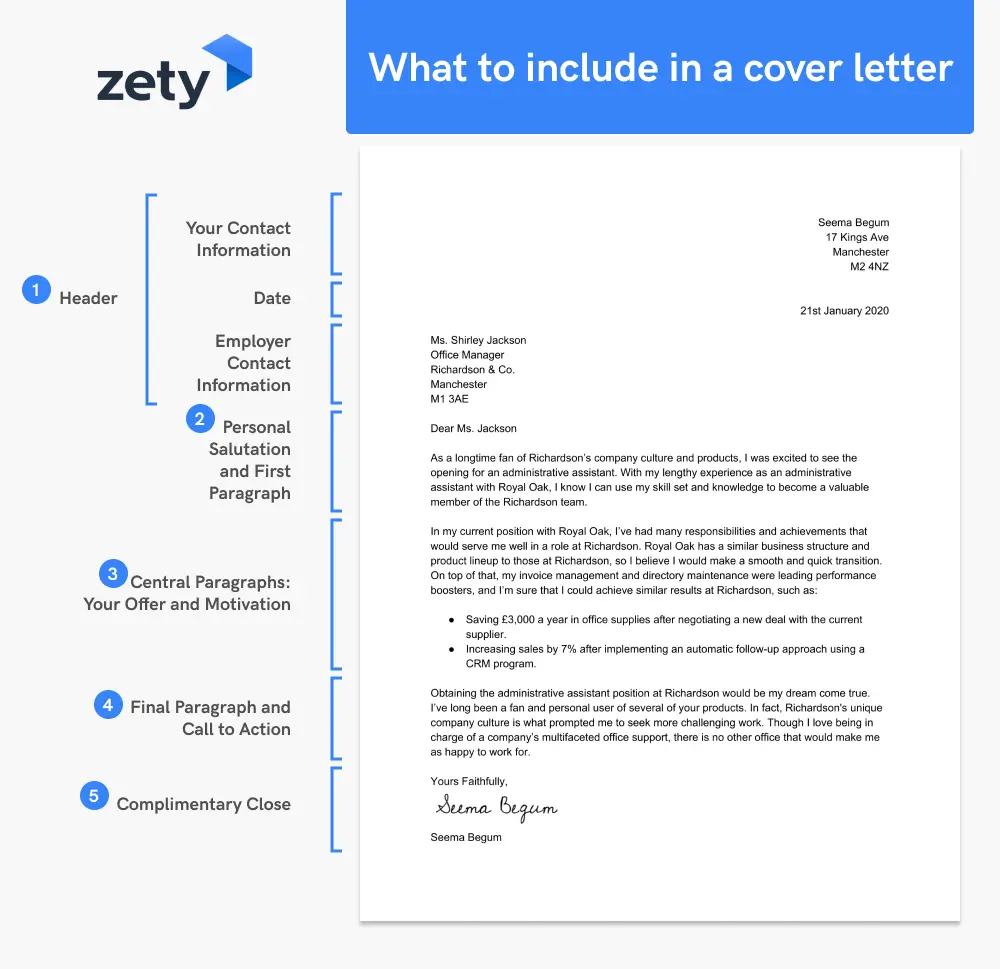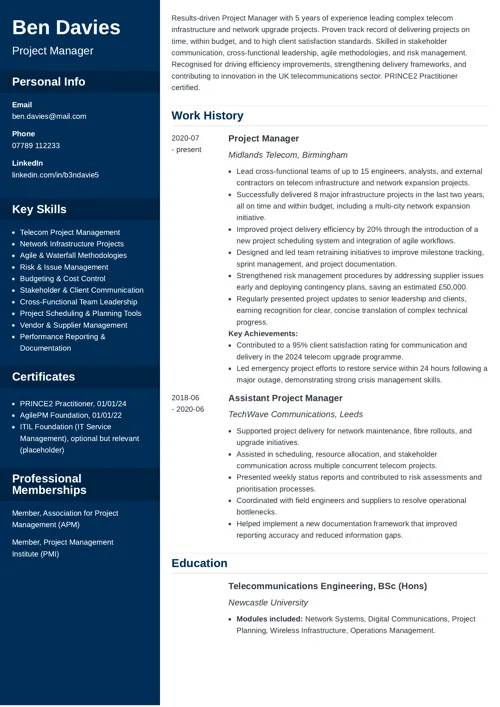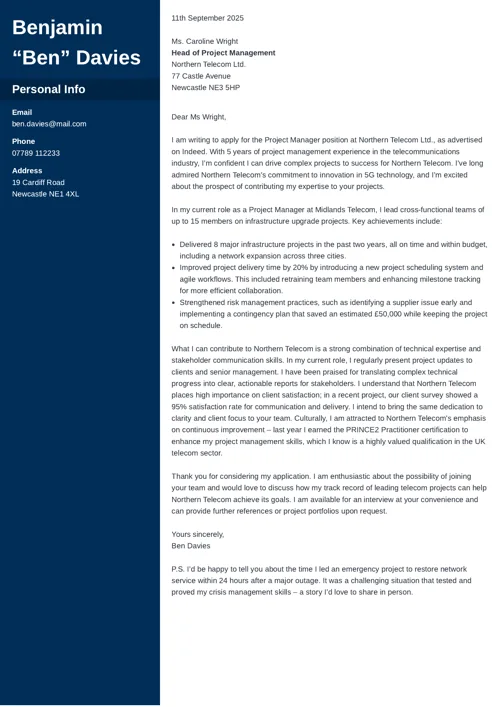How to Write a Cover Letter in the UK
Create your cover letter nowWriting a cover letter can be tricky. After all, it’s hard to write about yourself. You sit down, still wondering how to write a cover letter, and 3 hours later, all you have is a very cheeky cursor flashing on a blank screen.
Don’t worry, it’s not that hard once you learn how to create a cover letter. Just follow my tips!
This guide will show you:
- What is a cover letter, and why should you have one.
- How to write a cover letter that gets you invited for a job interview.
- Examples of perfectly-written cover letters as well as mistakes you must avoid.
Want to write your cover letter fast? Use our cover letter builder. Choose from 20+ professional cover letter templates that match your resume. See actionable examples and get expert tips along the way.
Sample Cover Letter for a CV—See more cover letter templates and create your cover letter here.
One of our users, Nikos, had this to say:
[I used] a nice template I found on Zety. My CV is now one page long, not three. With the same stuff.
Navigate this article with ease! Simply jump right into what interests you most:
- What is a cover letter?
- Why should you write a cover letter?
- How to write a cover letter in 10 steps
- Common cover letter mistakes to avoid
- Top 10 cover letter tips
- Professional cover letter examples
What is a cover letter?
A cover letter is a formal, one-page document you can send alongside your CV to introduce yourself and highlight your fit for the position. A cover letter complements your CV, explaining why you're suitable, showing your understanding of the company, and revealing your personality and motivation.
💡 If you’re seeking an internship, head here: How to Write a Cover Letter for an Internship
Why should you write a cover letter?
In a competitive labour market, knowing how to attract an employer’s attention is essential, and writing a cover letter can help you do that effectively. In fact, 83% of recruiters claim that a cover letter is an important part of every application process. Better not to risk it!
➡️ Here’s why writing a cover letter in the UK is a great idea:
- It shows recruiters you’re who they need: Use your cover letter to say how much you want this job and how your key qualifications, including your hard and soft skills, fit the job profile.
- It says you’re serious about the job: A well-written cover letter proves you’ve done due diligence on the company and the position.
- It connects your career trajectory to the company goals: When hiring managers see that your skills and experience are what the company needs, they’ll feel confident that you’re the right person for the job.
💡 Pro Tip: Ensure your cover letter matches your CV to create a strong first impression of someone who pays great attention to detail.
What to include in a cover letter?
When writing a cover letter, always include your contact details, a professional salutation, an introduction, information on why you are qualified for the job, a proper closing, and a complimentary close.
The easiest way to remember all that? Just follow the outline below:
📝 What should a cover letter include?
- Your contact info
- The company’s info
- Dear (hiring manager name)
- Paragraph #1: an introduction + a great job-fitting achievement
- Paragraph #2: your key skills + the reason you’re the perfect fit for the job
- Paragraph #3: your passion + why you want the job you’re applying for
- Paragraph #4: your CTA
- Best regards + your name + your title
- P.S. to add value

How to write a cover letter in 10 steps
A good cover letter complements your CV. They should work together like Peppa and George. Follow the rules described below, and you'll end up with an impressive, job-winning application document:
1. Use the right format for your cover letter
Before you start writing the masterpiece that will conquer the hearts of any recruiter in the United Kingdom and beyond, create the structure of the cover letter. Do it at the beginning, as adjusting the font size, margins, and spacing will help you maintain the proper length.
📝 How to format a cover letter?
- Select a cover letter template matching a CV you’ve written, or create one from scratch.
- Set a one-inch margin on all sides of your cover letter.
- Use 1–1.5 spacing throughout your document, as well as double space between paragraphs to boost readability.
- Align the letter contents to the left, except for your own contact info, which should be placed on the right.
- Select a good cover letter font sized at 11–12 points. Arial, Cambria, and Helvetica are some safe ones you can choose.
- Don’t exceed 3–5 paragraphs. That’s a bit over half of a page, or 250–300 words.
When you’ve done with writing, there’s one more thing: save your cover letter in PDF format. That way, you make sure its layout remains untouched.
💡 Pro Tip: Lying on a cover letter is like lying on a CV. Sooner or later, your superior will figure it out and trust me: nothing good will come from it.
2. Prepare the details you must include in the header
Begin your cover letter with a header. It’s the first thing the hiring manager notices, so get those details right. A cover letter header should match the CV header.
📌 How to create a proper cover letter header:
- On the right side, always include the following contact information:
- Full name
- Job title
- Address
- Phone number
- Email address
- On the left side, include the following information about your addressee:
- Their name
- Their title
- The name of the company
- The company address.
Add the current date, et voilà!
💡 Pro-tip: The structure of your cover letter header can differ if you choose a modern cover letter template, available in online cover letter building tools.
3. Address a cover letter properly
People respond well to seeing their names, so use that to your advantage. Depending on the company culture, use the hiring manager’s first or last name.
➡️ Here’s how to address the cover letter:
- If you're applying for a position in a relaxed startup, go for the first name.
- Use the last name if the company you're applying to is more conservative.
Once you make the effort to learn more about the person you’re writing to, the reader will want to know about you in return.
🔍 To find the name of the recipient of your cover letter:
- Google the company and look for a hiring manager position.
- Visit LinkedIn and check who works at the company.
- Contact the office directly and ask the receptionist for a hint.
💡 Pro Tip: If everything fails, opt for “Dear Hiring Manager”, as it’s way better than a dull “To Whom It May Concern”, or the “Sir/Madam” one.
4. Grab attention with an impressive introduction
Recruiters spend an average of 7 seconds looking at a CV. We can safely assume they spend even less time on a cover letter. Therefore, you must make a strong start. An opening paragraph in your cover letter will determine whether the recruiter continues reading. Your first few sentences should be as witty as Stormzy’s lyrics.
📝 How to write a cover letter’s opening paragraph:
- Avoid overly vague and cliché statements. Instead, grab the reader’s attention with a tailored introduction.
- Begin with a personal greeting to engage with the reader right from the start. Try to include the information about the company you're applying to.
- Show your excitement. Write passionately and enthusiastically. This is the perfect moment to prove that you are interested in this specific company.
Remember: few things annoy a hiring manager more than a cover letter that is obviously sent in the same format to several job openings across half of Britain. Always tailor your cover letter, and the introduction is the best place to do it.
➡️ Ask yourself these questions:
- Am I passionate about the company? Start with how their brand is the reason you’re applying.
- Do I have a passion for the role? Begin with how your professional or personal passion is the basis for why this job is for you.
- Do I have an accomplishment that really stands out? Demonstrate that your achievements are exactly what the company is looking for.
Ensure that each cover letter is personalised by mentioning specific details about the company and the role. Demonstrating that you've done your homework and expressing genuine interest can significantly enhance your application's appeal.
5. Demonstrate that you’re the perfect fit
After an excellent introduction, the main paragraphs follow. It's not enough to list your experience. Instead, show why you're the best candidate. Writing a cover letter is about showing, not telling.
📝 This is how to write a second paragraph of a cover letter:
- Highlight key accomplishments. Nothing proves that you're an outstanding candidate for the position more than what you’ve achieved and what you’re good at.
- Add numbers that prove value. That’s solid proof that your achievements had an impact.
- Name 2–3 key skills. Focus on the top keywords from the job requirements.
💡 Pro Tip: Keep it humble. You may be an experienced, talented musician, for example, but no one is going to believe that you’re the greatest thing since the Beatles.
6. Explain why you want to join this specific company
You’ve explained why you’re a good fit. Now, focus on why this company suits you. A good cover letter isn’t just flattery; it shows you genuinely want to work there, as employees who enjoy their job tend to stay longer.
📝 How to write a covering letter’s third paragraph?
- Make it personal: Reiterate that you want this specific job and not just any other job.
- Refer to the company and the issues it's facing. Visit their social media and website to stay up-to-date on what’s happening within their company.
- Include some relevant names. Maybe the CEO has recently given an interview, participated in a discussion panel, or posted something interesting on LinkedIn.
💡 Pro Tip: When visiting the company’s website and social media, gather as much information as possible. It will come in handy in your upcoming interview!
7. Conclude your cover letter flawlessly
It’s time for a cover letter ending. This is the moment where you can repeat your interest in the role and the company, and most of all, provide value.
📝 How to write a cover letter ending:
- Express your excitement about this chance: Suggest meeting them in person to discuss how your experience can help the company.
- Compliment your potential employer. Dropping something nice at the end of your cover letter is how you can get remembered as a friendly person.
- Try to schedule an interview. Convince them that both sides can win something by meeting face-to-face.
💡 Pro Tip: What seems like a bold move to take actually puts the ball in your recruiter’s court. That’s why asking for an interview and giving a precise time and place is a good idea. Also, that’s how you show your determination!
8. Sign off your cover letter
You’re almost done. It’s time I teach you how to create a cover letter sign-off. It would be a shame to have a perfectly written cover letter and then throw it away as an inappropriate signature, don’t you think?
📝 How to write a cover letter sign-off?
- Use “Yours sincerely” if you know the addressee’s name, e.g. ‘Dear Mr Sergeant’.
- Use “Yours faithfully” if you don’t, e.g. ‘Dear Marketing Team Manager’.
- Do NOT use informal sign-offs.
- Sign by hand if you’re handing a printed copy of your cover letter. If you’re feeling particularly creative, feel free to add a digital signature for a bit of personal charm.
Here are a handful of cover letter closings you can use:
- Best,
- Best regards,
- Kind regards,
- Most sincerely,
- Regards,
- Respectfully,
- Respectfully yours,
- Sincerely,
- Sincerely yours,
- Thank you,
- Thank you for your consideration,
- With best regards,
- Yours truly,
💡 Pro Tip: Unless you apply to a laid-back startup, keep it formal. In this case, you can aim for something a bit more relaxed. However, remember that it is always safer to go with the list above than a sing-off such as Cheers!, May the Odds Be Ever in Your Favour, See Ya Later Alligator, or Ta-ra!
9. Add a powerful postscript
You’ve got your cover letter ready. But don’t hit that “Send” button just yet. There’s one more trick you can use—it’s the postscript. Trust me: it’s like a cherry on top of your job-winning cover letter. And it’s how you can highlight one more impressive thing about you.
📝 How to write a cover letter postscript?
- Choose an awe-inspiring achievement. Write something remarkable about your career, even if it’s not really related to the job opening.
- Express that you would love to share how you achieved it, what difference it makes, and how you see a chance of using that experience in their company.
- Offer to share your knowledge during an interview. It works like a hook, which makes them interested in what you have to say.
💡 Read more: 5 Short Cover Letters to Get You Inspired
10. Proofread your cover letter
Once you write a fantastic cover letter with an ideal header, a captivating introduction, a jaw-dropping middle, and an ending that keeps the reader interested… Don’t let any error ruin that.
Always double-check your cover letter. You can ask for help from your friends and family. Or you can use a checker available in online cover letter builders.
Getting pro tips and hints from CV and cover letter specialists will boost your chances of getting hired and boost your confidence in landing that interview you’re after. Once your confidence is sky-high, nothing can stop you from getting the job of your dreams!
💡 Pro Tip: Always be careful with spelling. Making a silly mistake is a huge red flag for your potential employer.
Common cover letter writing mistakes to avoid
Recruiters see countless applications, and there are some mistakes they simply don’t forgive.
📌 Avoid these common pitfalls that UK employers cite as deal-breakers:
- Don’t send a generic cover letter. Recruiters spot generic content quickly. Always tailor your cover letter to the company and role, mentioning specific details that show genuine interest.
- Don’t use overly formal language. Keep it professional but natural, and steer clear of slang or jokes. Aim for polite, conversational professionalism.
- Don’t address the wrong person or company. Double-check names, titles, and company references. Mistakes such as mixing up employers or misgendering someone demonstrate carelessness and can damage your chances.
- Don’t make any typos or grammar errors. Errors undermine credibility. Use spell-check tools, proofread aloud, and ideally get another set of eyes to review.
- Don’t repeat your CV word-for-word. Your cover letter should add context, not copy your CV. Highlight how past roles prepared you for this job, and bring your achievements and motivation to life.
- Don’t write a cover letter that is too long or too short. Stick to 250–400 words (3–5 paragraphs). Too long risks losing the reader; too short signals a lack of effort.
- Don’t focus on what you want. Avoid making the letter all about you. Emphasise how you’ll add value to the company, while showing enthusiasm for growing within the role.
- Don’t use clichés and vague statements. Skip buzzwords like “hard-working team player.” Use specific examples that demonstrate your qualities, proving strengths instead of just claiming them.
- Don’t lie or exaggerate. Never fabricate degrees, skills, or experience. Dishonesty will be uncovered in interviews or on the job and can immediately end your chances.
- Don’t forget to sign the letter. If submitting a hard copy, sign above your name. For digital submissions, type your name and include contact details so employers can easily reach you.
By steering clear of these common mistakes, you significantly increase your cover letter’s chances of hitting the mark.
💡 Read more: Speculative Cover Letter
Top 10 cover letter writing tips from career experts
To wrap up this guide, here's a quick list of 10 expert tips to ensure your cover letter stands out:
- Mirror the job description. Use keywords from the job ad naturally. ATS often scan for these, so align your wording (e.g., “stakeholder management,” “Agile”) to show you understand the role.
- Focus on the employer’s needs. Frame your experience around employer value. Instead of “This job will help me grow,” say how your skills can help them achieve their goals.
- Show genuine enthusiasm and personality. Keep it professional, but let your passion show. Express real excitement for the role, but avoid forced humour or over-the-top enthusiasm.
- Use the STAR method for examples. Structure achievements with Situation, Task, Action, Result. This keeps examples clear, concise, and demonstrates both impact and context.
- Name your file professionally. Use clear, identifiable filenames (e.g., “Amir_Zahid_CoverLetter.pdf”). It shows organisation and makes your document easy to find.
- Avoid jargon and buzzwords. Use plain English instead of vague jargon. Write so that any reader, including HR, can easily understand your achievements.
- Match the company’s tone. Research the company’s communication style and reflect it. Err on the side of formal if unsure, but adapt where appropriate.
- Follow instructions to the letter. Read job posting requirements carefully. Provide requested details and follow formatting directions—skipping them can disqualify you.
- Ask someone else to review your letter. If not possible, read aloud or print it out to catch errors and refine clarity.
- Keep a copy for yourself. Save each final version for interviews and future applications. It helps you prepare, repurpose strong phrasing, and track what works.
💡 Now that you know how to write a cover letter, let’s figure out another important aspect of your application process. Read more: How to Write a CV
Professional cover letter examples for various applicants
Below are three cover letter samples, written for different experience levels. Note how each letter follows the structure and tips outlined above, while showcasing the candidate’s unique background. Use these examples for inspiration on tone, content, and formatting.
Entry-level cover letter example
Alice Thompson
221B Baker Street
London W1U 6RS
alice.thompson@example.com
07123 456789
Hiring Manager
TechFuture Innovations
45 Innovation Park
Manchester M1 3GY
11th September 2025
Dear Hiring Manager,
I am excited to apply for the Project Manager (Graduate Programme) position at TechFuture Innovations. As a recent MSc Management graduate from University of Leeds with a strong interest in tech projects, I was thrilled to find an opportunity that perfectly aligns with my academic background and passion. TechFuture’s reputation for cutting-edge projects and continuous learning is exactly what I am looking for as I launch my career.
During my studies and internship, I gained valuable project management experience, including:
- Led a team of 5 to develop a mobile app prototype within an 8-week deadline, managing weekly sprints and coordination.
- Gained hands-on experience in scheduling, team communication, and agile methodology, preparing me to contribute effectively in real-world projects.
- Introduced a new task management tool, boosting task completion rates by 15% in the final month of the internship.
What attracts me most to TechFuture is your emphasis on mentorship and development. I was pleased to see on your website that each new project manager is paired with a senior mentor. As someone who values feedback and ongoing improvement, I am confident I would quickly adapt and make a positive contribution to your team’s projects. I am especially interested in your IoT development project (mentioned in your latest press release), having researched IoT management during my dissertation. I would love to assist in coordinating such innovative work and learn from the best in the industry.
Thank you very much for considering my application. I would welcome the opportunity to discuss how my teamwork, quick learning, and project management skills can benefit TechFuture Innovations. I am available for an interview at your earliest convenience and can be reached via email or phone.
Yours faithfully,
Alice Thompson
P.S. I’m eager to share how I managed a charity hackathon project that raised £5,000 in 48 hours – it was an intense experience that taught me how to deliver results under pressure. I’d be happy to talk about what I learned from it during an interview!
Mid-level cover letter example
Benjamin “Ben” Davies
19 Cardiff Road
Newcastle NE1 4XL
ben.davies@mail.com
07789 112233
Ms. Caroline Wright
Head of Project Management
Northern Telecom Ltd.
77 Castle Avenue
Newcastle NE3 5HP
11th September 2025
Dear Ms Wright,
I am writing to apply for the Project Manager position at Northern Telecom Ltd., as advertised on Indeed. With 5 years of project management experience in the telecommunications industry, I’m confident I can drive complex projects to success for Northern Telecom. I’ve long admired Northern Telecom’s commitment to innovation in 5G technology, and I’m excited about the prospect of contributing my expertise to your projects.
In my current role as a Project Manager at Midlands Telecom, I lead cross-functional teams of up to 15 members on infrastructure upgrade projects. Key achievements include:
- Delivered 8 major infrastructure projects in the past two years, all on time and within budget, including a network expansion across three cities.
- Improved project delivery time by 20% by introducing a new project scheduling system and agile workflows. This included retraining team members and enhancing milestone tracking for more efficient collaboration.
- Strengthened risk management practices, such as identifying a supplier issue early and implementing a contingency plan that saved an estimated £50,000 while keeping the project on schedule.
What I can contribute to Northern Telecom is a strong combination of technical expertise and stakeholder communication skills. In my current role, I regularly present project updates to clients and senior management. I have been praised for translating complex technical progress into clear, actionable reports for stakeholders. I understand that Northern Telecom places high importance on client satisfaction; in a recent project, our client survey showed a 95% satisfaction rate for communication and delivery. I intend to bring the same dedication to clarity and client focus to your team. Culturally, I am attracted to Northern Telecom’s emphasis on continuous improvement – last year I earned the PRINCE2 Practitioner certification to enhance my project management skills, which I know is a highly valued qualification in the UK telecom sector.
Thank you for considering my application. I am enthusiastic about the possibility of joining your team and would love to discuss how my track record of leading telecom projects can help Northern Telecom achieve its goals. I am available for an interview at your convenience and can provide further references or project portfolios upon request.
Yours sincerely,
Ben Davies
P.S. I’d be happy to tell you about the time I led an emergency project to restore network service within 24 hours after a major outage. It was a challenging situation that tested and proved my crisis management skills – a story I’d love to share in person.
Senior-level cover letter example
Dr. Samantha Lee, PMP
The Laurels, 58 Kings Road
Bristol BS8 2QQ
samantha.lee.pro@example.com
07555 998877
Mr. Jonathan Evans
Director of Operations
GreenTech Solutions
10 Harbor Drive
Bristol BS1 4AH
11th September 2025
Dear Mr Evans,
As a Senior Project Manager with over 10 years of experience delivering large-scale IT and sustainability projects, I was excited to learn of the opening at GreenTech Solutions. Your company’s mission to drive eco-friendly innovation in cloud services resonates strongly with me. I’m applying for the Senior Project Manager position with the confidence that my extensive background in both project leadership and green technology initiatives can significantly benefit your upcoming projects.
In my current role at FutureGen Systems, I manage a portfolio of IT infrastructure and energy-efficiency initiatives. Some highlights include:
- Led a £5M data centre optimisation project that reduced energy consumption by 30%, delivered two months ahead of schedule, and recognised with the 2024 UK Tech Sustainability Award.
- Directed an enterprise software rollout to 5,000 users across multiple sites, delivered £100K under budget through scope management and vendor negotiations.
- Proven ability to deliver complex, large-scale projects while balancing scope, budget, stakeholder expectations, and quality outcomes.
I am attracted to GreenTech Solutions due to your reputation as a pioneer in combining technology with sustainability. After attending your CEO’s talk at the 2023 Green Tech Conference, I was impressed by your goals to reduce carbon footprints through innovative cloud solutions. My PhD in Computer Science (specialising in Green Computing), along with project management experience and PMP certification, equip me to contribute both thought leadership and effective execution. I thrive in forward-thinking environments, implementing continuous improvement through reviews and mentorship. I’ve mentored four junior project managers, two of whom have been promoted, demonstrating my commitment to developing talent, aligning with GreenTech’s values.
Thank you for considering my application. I would be thrilled to join GreenTech Solutions and help drive your projects to new heights of success. I am eager to discuss how my leadership and strategic planning can advance your mission. Please feel free to contact me to arrange an interview; I am flexible and can adjust to your schedule.
Yours sincerely,
Samantha Lee
P.S. I recently authored a case study on sustainable project management practices for the Project Management Journal – I’d love to share insights from that experience and how they could apply to GreenTech’s projects when we speak.
Plus, a great cover letter that matches your CV will give you an advantage over other candidates. You can write it in our cover letter builder here. Here's what it may look like:
See more cover letter templates and start writing.
Key Takeaway
I am sure you’ve gained useful insight and tips that will help you write yours in a jiffy.
📌 Keep these best cover letter writing practices in mind:
- Create a proper cover letter header.
- Address your cover letter professionally.
- Start with a strong opening statement.
- Say how the company can benefit from your skills and knowledge.
- State why the company is a great fit for you, and make them believe you’ll be a loyal employee.
- Finish your cover letter with a professional closure
- And a professional sign-off.
- Add a postscript to highlight one more achievement and make them want to meet you in person.
- Proofread it to spot all the mistakes you might have made.
But with a cover letter guide like this, you won’t make many mistakes anyway. Good luck!
About Zety’s Editorial Process
Our editorial team has thoroughly reviewed this article to ensure it follows Zety’s editorial guidelines. Our dedication lies in sharing our expertise and providing you with actionable career advice that offers you real value. Every year, the quality of our content attracts 40 million readers to our site. But that’s not all – we conduct original research to gain a detailed understanding of the labour market. We take pride in being cited by top universities and leading media outlets in the UK and worldwide.
Sources
- Human Resources Online, "Are cover letters important? 83% of recruiters say yes"
- Dennis P. Carmody, Michael Lewis, "Brain Activation When Hearing One’s Own and Others’ Names"
- Mercy University, "Eye tracking study shows recruiters look at resumes for 7 seconds"
- National Careers Service, "The STAR method"
- CIPD, "Labour Market Outlook"






![CV Layout: How to Lay Out a Professional CV [5+ Examples]](https://cdn-images.zety.com/pages/cv_layout_uk_9.jpg?fit=crop&h=250&dpr=2)